October 17, 2025

The title '10 Essential Applied Behavior Analysis Techniques for BCBAs' highlights a crucial focus on the key techniques that Board Certified Behavior Analysts (BCBAs) must employ in their practice.
In a landscape where the demand for BCBAs continues to rise, understanding these techniques is paramount.
The article delineates various applied behavior analysis techniques, including:
Each technique is underscored for its effectiveness in enhancing communication and social skills in individuals with autism.
This exploration provides BCBAs with indispensable strategies to elevate therapeutic outcomes.
Are you ready to implement these essential techniques in your practice? By doing so, you can significantly improve the lives of those you serve.
The increasing demand for Board Certified Behavior Analysts (BCBAs) presents both a challenge and an opportunity in the field of applied behavior analysis (ABA). As the profession evolves, understanding and implementing essential ABA techniques becomes crucial for practitioners aiming to enhance client outcomes. This article delves into ten key strategies that not only facilitate effective therapy but also empower BCBAs to navigate the complexities of their roles.
How can these techniques transform the landscape of behavioral health and ensure that practitioners meet the growing needs of their clients?
With the (BCBAs) projected to surge by 25% by 2026, the need for effective recruitment solutions has never been more critical. Hire ABA serves as a specialized recruitment platform designed to enhance the job search experience for BCBAs. By leveraging advanced algorithms and robust industry connections, it effectively matches qualified candidates with premier job opportunities in ABA therapy.
Are you struggling to find the right talent for your ABA practice? Our personalized resume assessments thoroughly evaluate each candidate's experience and career goals. This allows us to utilize advanced job fit scoring, identifying opportunities that align with their skills, preferences, and desired locations. This streamlined process not only accelerates the job search for candidates but also enables employers to efficiently pinpoint the right talent through applied behavior analysis techniques, thereby enhancing the overall quality of care in ABA settings.
Successful case studies have shown that platforms like Hire ABA significantly improve job placement success rates. This underscores the essential role of technology in recruitment processes. By adopting Hire ABA's specialized recruitment strategies, you can effectively meet the growing need for BCBAs in your organization. Don't miss out on the opportunity to elevate your hiring process—partner with Hire ABA today to secure the best talent for your ABA therapy needs.
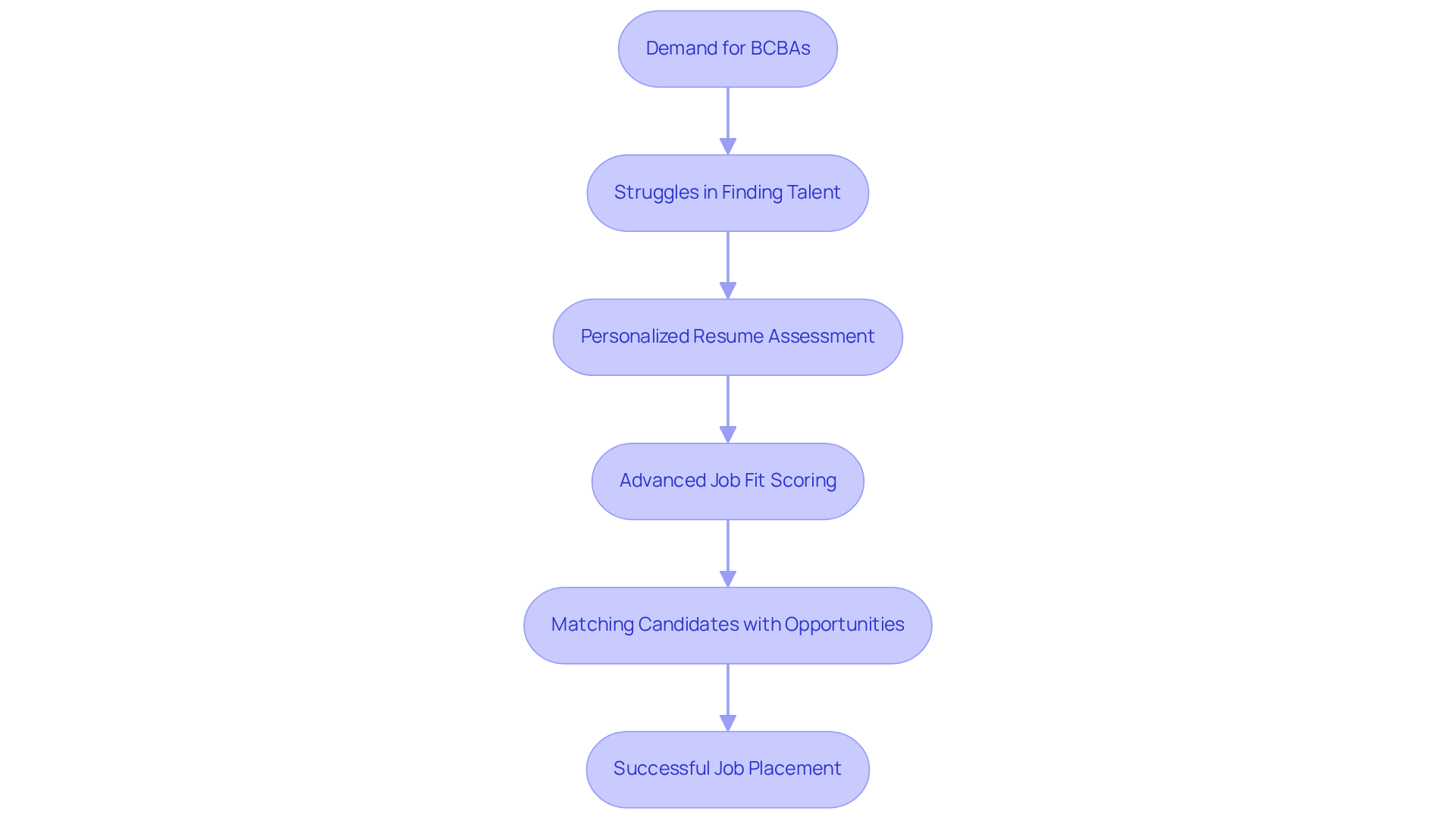
Positive reinforcement is a cornerstone of applied behavior analysis techniques, providing a reward immediately after a desired behavior to significantly increase the likelihood of its recurrence. This effective reinforcement can manifest in various forms, such as verbal praise, tokens, or tangible rewards, each meticulously tailored to meet the individual needs and preferences of clients. Current trends underscore the importance of customizing these strategies to ensure that rewards resonate with the young individual, thereby enhancing motivation and engagement.
Recent research highlights the effectiveness of positive reinforcement when combined with shaping techniques, which break down complex abilities into manageable steps. For example, a structured token economy system can be established, allowing young individuals to earn tokens for positive behaviors, which can later be exchanged for larger rewards. This not only teaches the value of but also encourages skill development while boosting confidence as young learners experience success at each stage.
It is essential for BCBAs to continuously monitor the effectiveness of reinforcement strategies, adjusting them as necessary to sustain interest and motivation. The immediate delivery of reinforcement is crucial; it aids children in making clear connections between their actions and the rewards they receive. Moreover, integrating positive reinforcement into daily practices can substantially enhance learning outcomes, as parents and caregivers reinforce preferred actions beyond therapy sessions. Family engagement plays a vital role, as parents can cultivate a supportive atmosphere that bolsters the structured education provided by behavior analysts.
The effective application of applied behavior analysis techniques has demonstrated that young individuals can show progress in communication, social interactions, and adaptive behaviors within weeks, although some may require extended periods of consistent support. By focusing on personal interests and preferences, BCBAs can create a nurturing environment that not only promotes positive behaviors but also fosters long-term development and self-regulation. As highlighted by Inclusive ABA, "Positive reinforcement is a fundamental aspect of ABA therapy, assisting children with autism in developing crucial life competencies, minimizing challenging behaviors, and boosting confidence.

Discrete Trial Training (DTT) stands out as a systematic method that breaks down abilities into small, manageable parts, promoting targeted instruction and evaluation. Did you know that nearly half of participants in DTT programs achieve excellent results? Each trial consists of a clear instruction, a response from the learner, and a consequence—either reinforcement or correction. This method, utilizing , proves effective for teaching a variety of skills, from language acquisition to social interactions, making it particularly beneficial for clients on the autism spectrum. Research shows that an additional 42% of participants demonstrate noticeable progress.
Success in DTT is often measured by clear mastery criteria, such as achieving five consecutive correct responses. BCBAs emphasize that immediate positive reinforcement is crucial for solidifying learning connections, and that applied behavior analysis techniques, including accurate data collection, guide instructional decisions and allow for tailored adjustments to teaching strategies. Have you considered how collaborative goal setting between caregivers and clinicians can ensure that the training is customized to each individual's unique needs?
By integrating applied behavior analysis techniques with DTT and natural environment training (NET), children can utilize acquired abilities in real-world situations, significantly improving their communication and interaction capacities. As Dr. O. Ivar Lovaas aptly stated, 'By combining clear instructions with consistent reinforcement and data collection, discrete trial training fosters dependable advancement in communication, social interactions, and daily living tasks.' Overall, DTT not only encourages ability development but also empowers individuals with autism to achieve their full potential.
For healthcare employers, executing DTT strategies efficiently can necessitate regular training sessions for staff and continuous collaboration with families. This ensures that the method is tailored to each individual's needs, ultimately enhancing the effectiveness of the training provided.
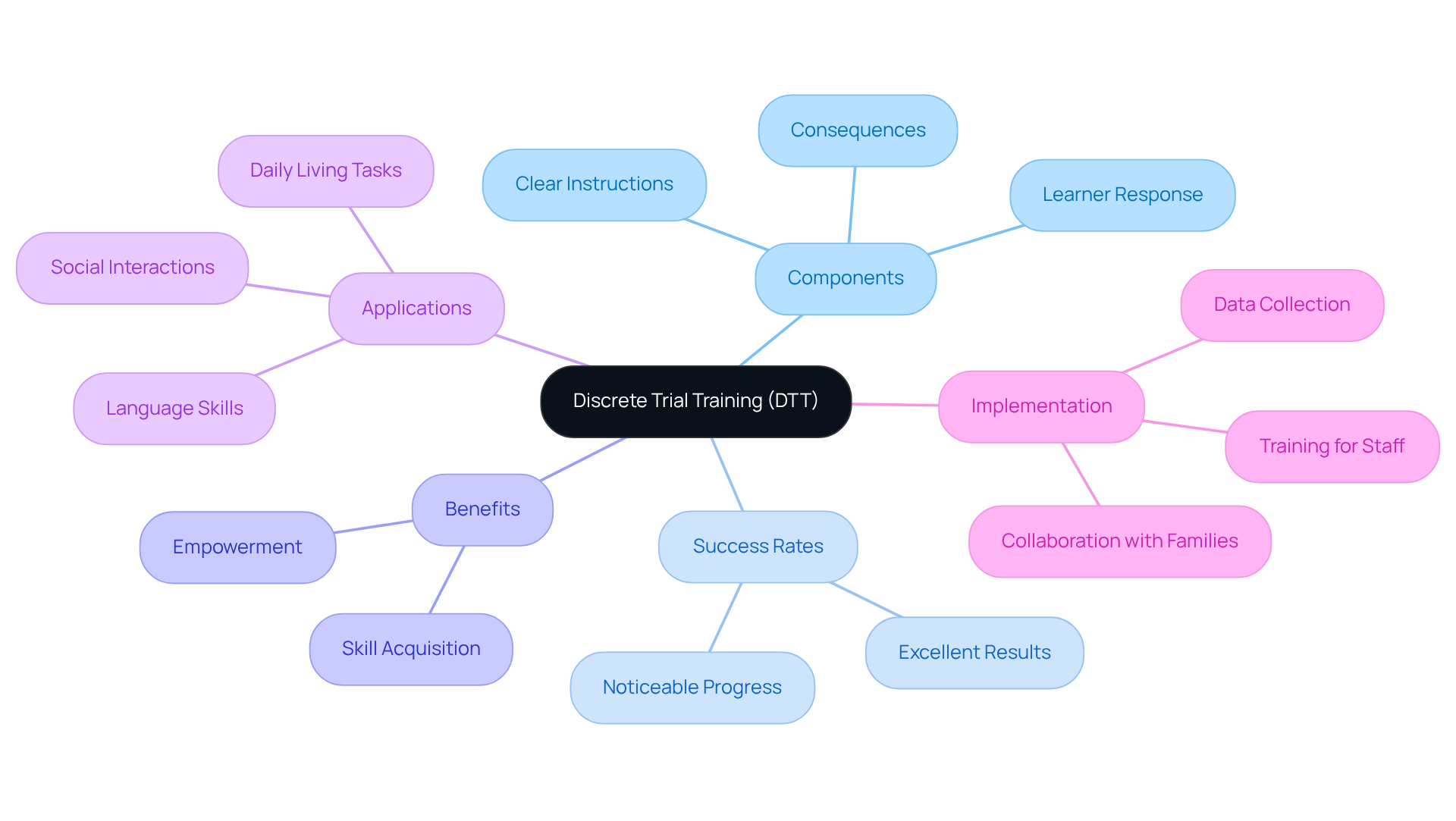
Pivotal Response Treatment (PRT) stands as a well-established, evidence-based intervention pioneered by Dr. Robert L. Koegel and Dr. Lynn Kern Koegel at Stanford University. This innovative approach zeroes in on such as motivation, self-management, and social initiations. By enhancing these essential abilities, PRT aims to foster significant advancements across various domains of functioning in children with autism. Research underscores that PRT's naturalistic approach, emphasizing child-led interactions, yields broader behavioral gains and enhances communication skills.
How can BCBAs effectively implement PRT? By creating engaging, naturalistic learning opportunities that promote interaction and participation. This method not only encourages children to take initiative but also seamlessly integrates learning into everyday activities, establishing it as a practical choice for therapy settings. Experts emphasize that the motivational components of PRT are crucial, as they help mitigate off-task behaviors and elevate engagement during sessions.
Recent research corroborates the efficacy of PRT, revealing notable advancements in social communication and overall developmental abilities. The PRT group demonstrates greater improvements in Mean Length of Utterance (MLU) compared to structured ABA methods. These compelling findings reinforce the value of PRT within the field of applied behavior analysis techniques, prompting professionals to consider its implementation in their practice.
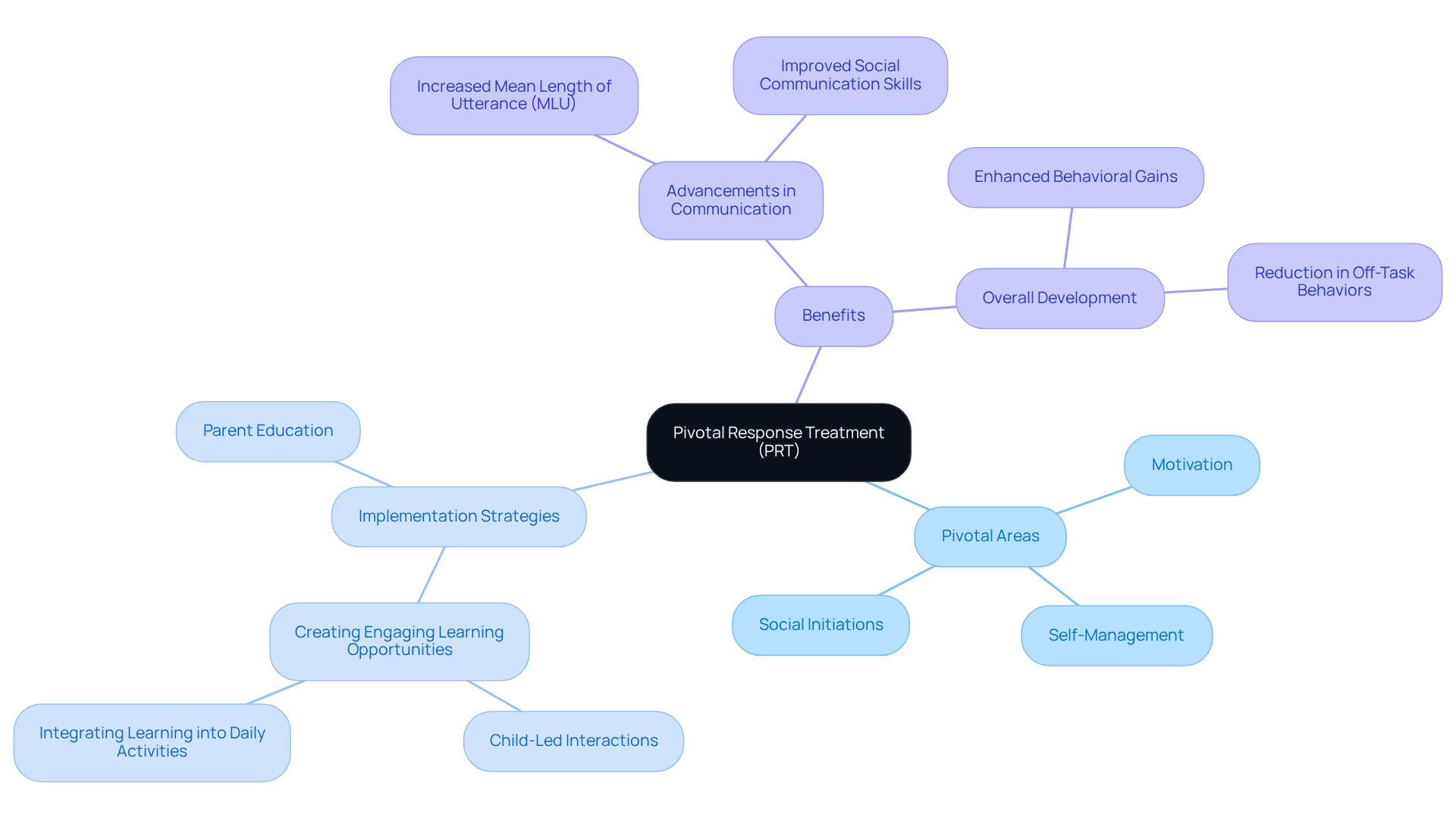
The Early Start Denver Model (ESDM) stands as a comprehensive intervention tailored for individuals aged 12 to 48 months, seamlessly integrating applied behavior analysis techniques with developmental principles. This model emphasizes play-centered learning, which is crucial for fostering essential social, communication, and cognitive skills. Research indicates that ESDM significantly enhances language capabilities, adaptive behavior, and social-emotional competencies, solidifying its role as a vital early intervention approach for children with autism.
Implementing ESDM involves parent-implemented training sessions, typically spanning 1 to 2 hours each week over a duration of 10-13 weeks, underscoring the commitment necessary for effective application. Board Certified Behavior Analysts (BCBAs) can utilize applied behavior analysis techniques, including ESDM, to craft engaging and effective intervention plans that cater to the unique needs of young clients, thereby ensuring a supportive and nurturing environment that fosters lasting developmental progress.
The emphasis on parental participation further enriches the therapeutic process; indeed, in youth communication and social skills. Nonetheless, it is essential to acknowledge that only half of the studies evaluating ESDM have met the benchmark of 80% fidelity in parent implementation, revealing challenges in its application.
Moreover, ESDM has demonstrated effectiveness for children as young as 18 months, and its adaptable nature allows for delivery in diverse settings, including home, clinic, and school, thus making it accessible for families. Regular assessments every 12 weeks are vital for establishing specific goals and ensuring continuous improvement in the intervention process.
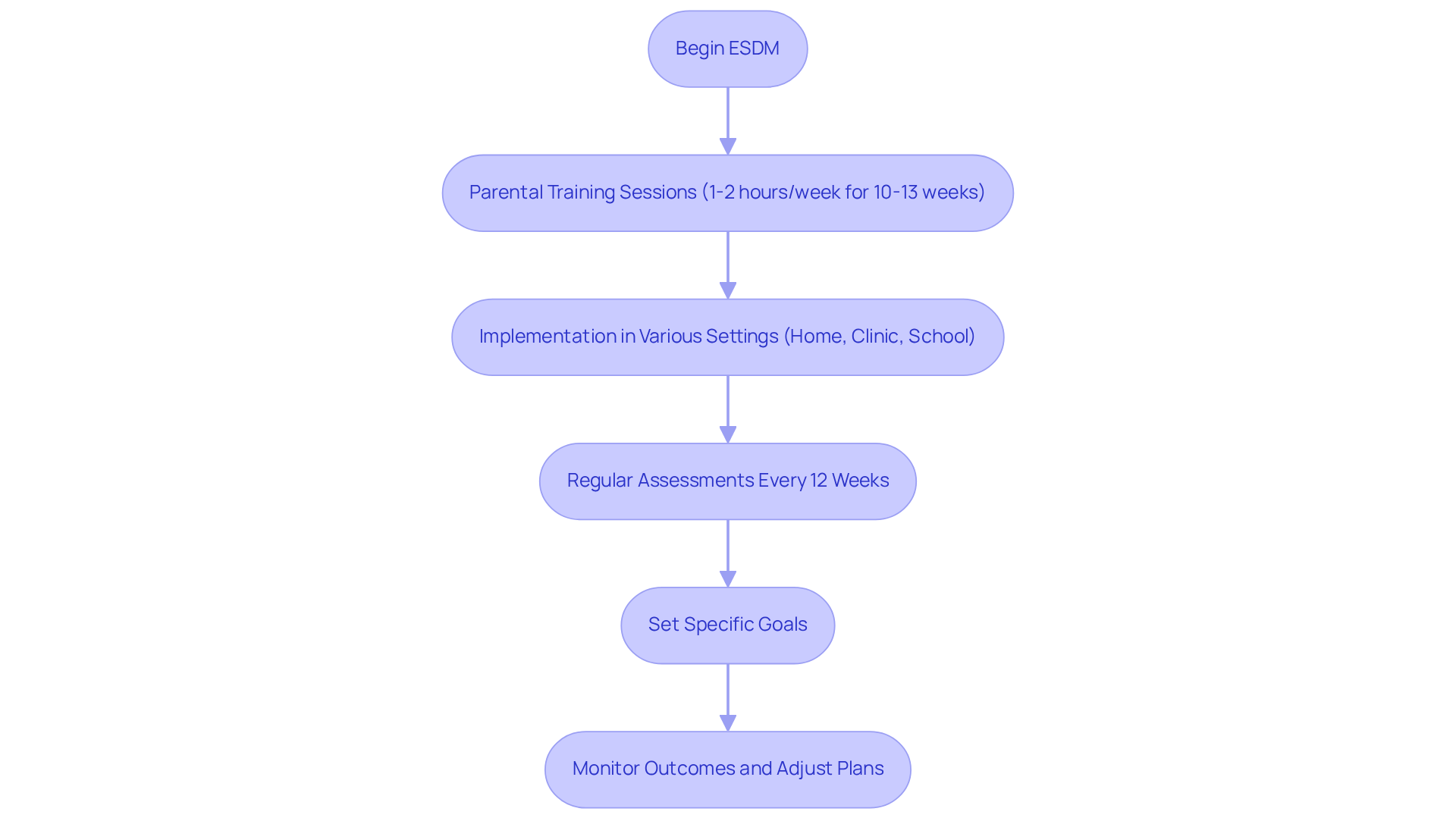
Functional Behavior Assessment (FBA) serves as a critical framework for understanding the underlying causes of challenging behaviors in individuals. This systematic process involves through various methods, including direct observations, structured interviews, and assessments. Such practices empower Board Certified Behavior Analysts (BCBAs) to accurately identify the function of a behavior—whether it be seeking attention, avoiding a situation, or obtaining a specific item. These insights are essential for crafting targeted intervention strategies that effectively address the root causes of behaviors through applied behavior analysis techniques.
Recent studies underscore the effectiveness of applied behavior analysis techniques, particularly in formulating intervention plans, revealing significant improvements in outcomes when these assessments are implemented effectively. For example, successful applications of applied behavior analysis techniques have demonstrated that tailored interventions can markedly reduce disruptive behaviors, thereby enhancing overall engagement in therapeutic settings. As the demand for BCBAs continues to escalate, it becomes imperative for practitioners to remain informed about current trends in FBA usage to optimize their approaches and outcomes in Applied Behavior Analysis.
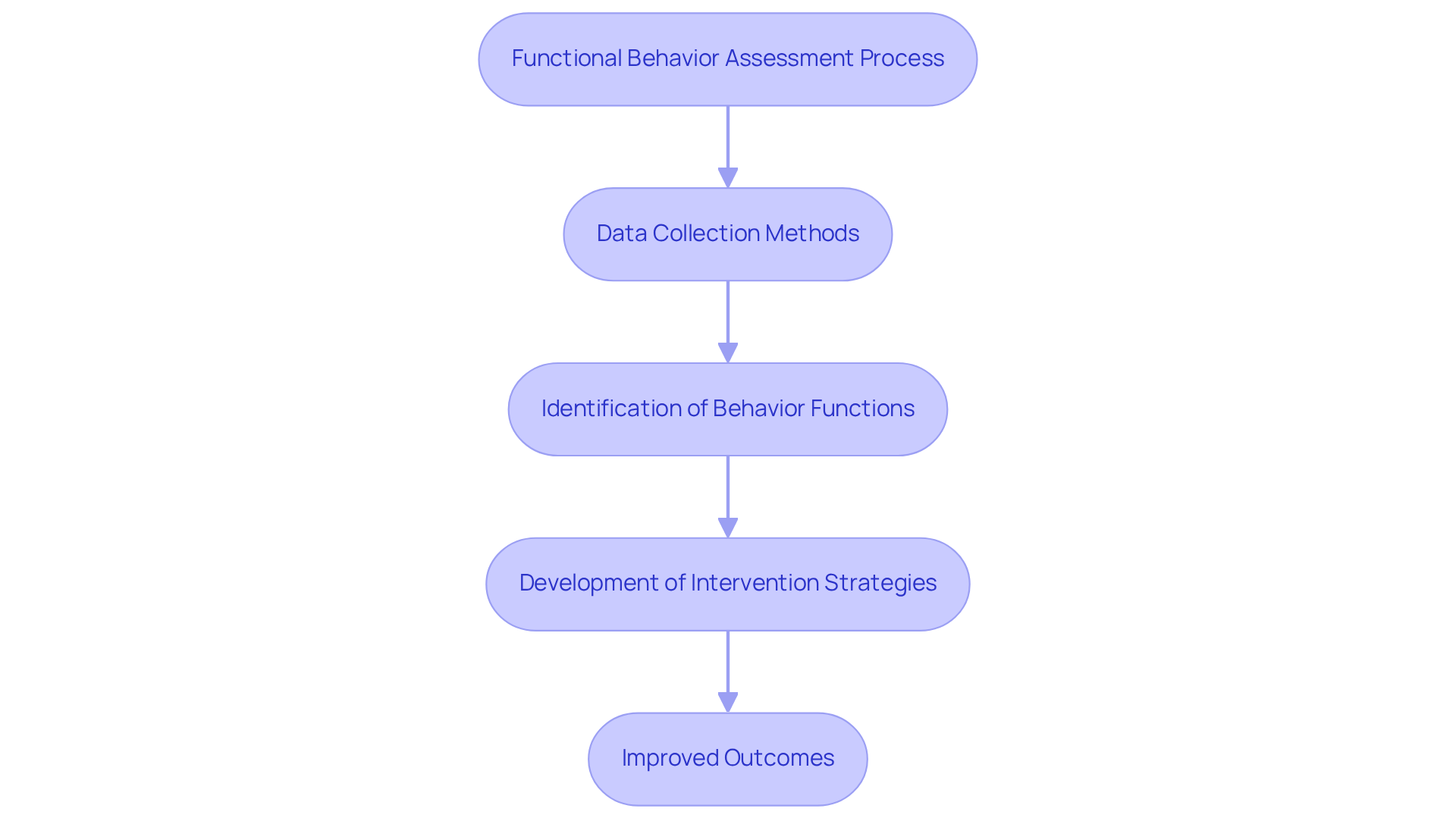
Visual supports—including schedules, charts, choice boards, social stories, and token systems—are indispensable in enhancing communication and understanding for clients in ABA therapy. These tools provide of information, facilitating the processing and responding to instructions. For instance, visual schedules help young learners anticipate daily routines, effectively lowering anxiety and fostering independence. Research underscores that visual supports can significantly improve communication for non-verbal or minimally verbal children by offering essential channels for expression. A mini schedule can promote student independence and reduce avoidance behaviors.
BCBAs must leverage a variety of visual aids tailored to each client's unique needs, ensuring accessibility and engagement. Personalized visual supports have been shown to alleviate anxiety and enhance comprehension by breaking down complex information into manageable elements. The efficient use of applied behavior analysis techniques not only promotes increased independence but also supports behavior management, leading to significant progress for individuals with autism.
Recent studies highlight the effectiveness of visual supports in enhancing decision-making abilities, particularly through choice boards that present various options for children with verbal challenges. Additionally, contingency maps serve as straightforward methods to teach students new skills, further illustrating the versatility of visual aids in ABA therapy. By integrating these innovative tools, behavior analysts can improve communication outcomes and empower clients to navigate their environments more effectively.
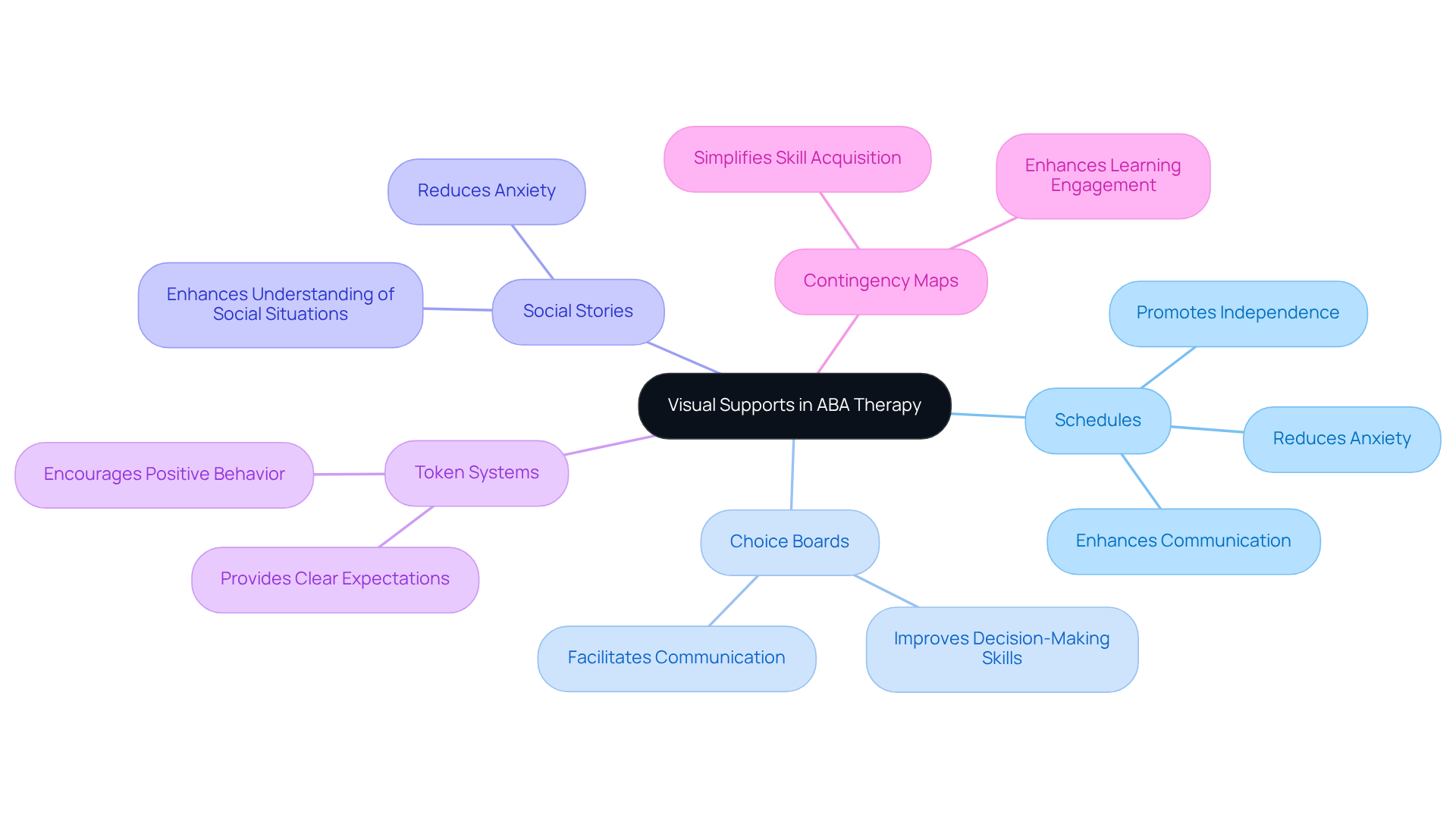
Social development training is vital for empowering clients to engage effectively with others, fostering meaningful relationships, and enhancing their ability to navigate social situations. Board Certified Behavior Analysts (BCBAs) are equipped to employ applied behavior analysis techniques, such as role-playing, modeling, and direct instruction, to impart essential skills, including initiating conversations, taking turns, and interpreting nonverbal cues. By integrating applied behavior analysis techniques into therapy sessions and everyday interactions, learning is reinforced, and the application of skills is encouraged across various contexts.
Current trends highlight the necessity of individualized planning and comprehensive assessments, allowing for tailored programs that address each client's unique strengths and challenges. Have you considered how involving parents and caregivers in the training process can be instrumental in maintaining and generalizing the skills learned? This involvement ensures clients can effectively in real-world scenarios.
As the field continues to advance, innovative solutions such as Behavioral Intervention Technologies (BITs) are emerging as effective complements to traditional methods, offering flexible and accessible learning opportunities for clients. The demand for BCBAs is growing—are you ready to leverage these advancements to enhance your practice? Embrace these strategies to not only improve client outcomes but also to elevate your professional standards.
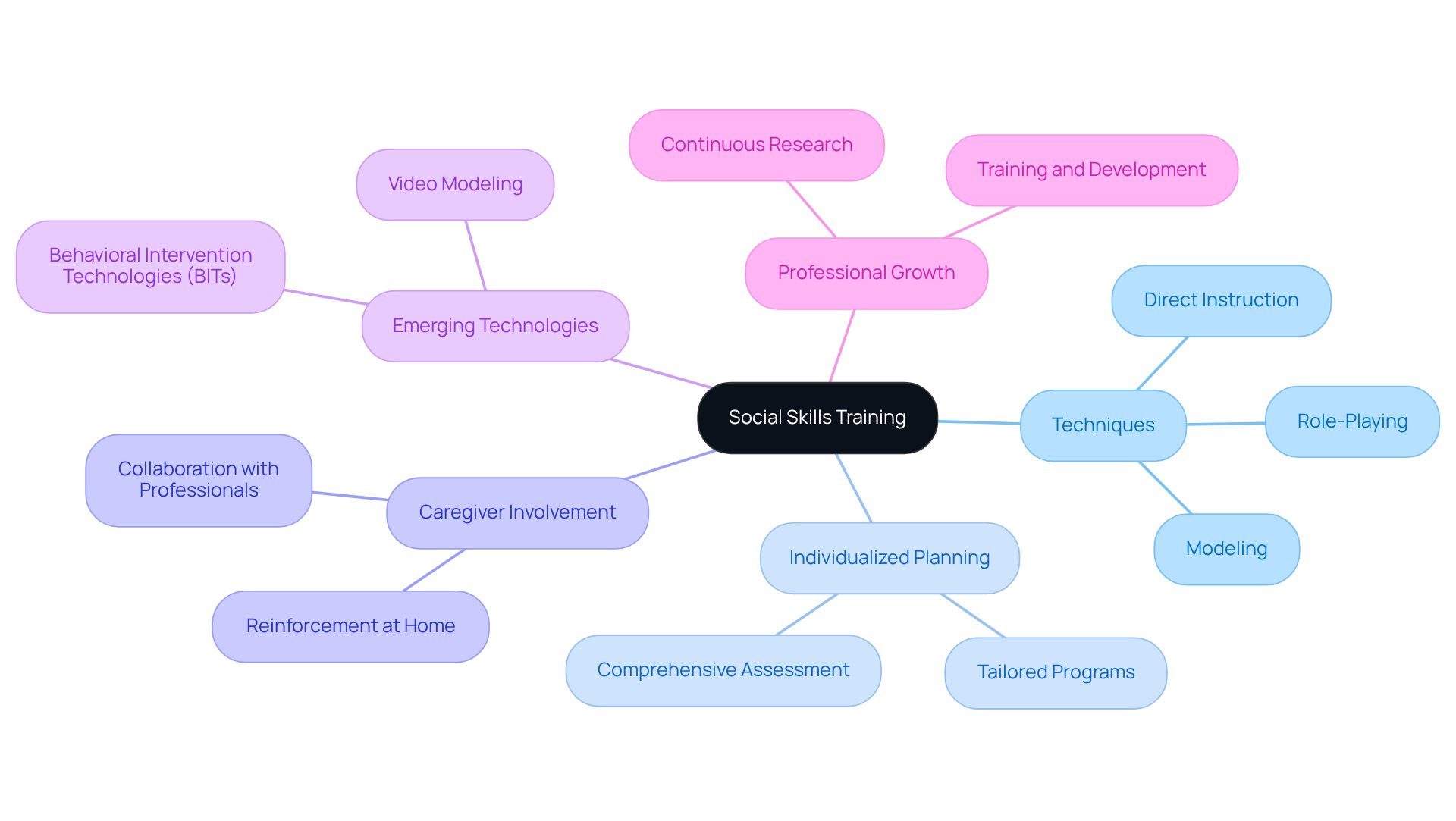
Data collection and analysis are fundamental components in monitoring client progress and assessing the effectiveness of interventions that utilize applied behavior analysis techniques within ABA therapy. Board Certified Behavior Analysts (BCBAs) must utilize a range of data collection techniques, including:
to capture essential behavioral information. This systematic approach aids in the precise monitoring of client actions and enables practitioners to make informed choices about intervention adjustments and the creation of new objectives.
Current trends in data analysis emphasize the integration of technology, such as digital tools like Alpaca Health, which automate data entry and enhance accuracy. These advancements allow for real-time insights, enabling timely adjustments to treatment plans based on ongoing client responses. Furthermore, evidence-based practices underscore the necessity of aligning data analysis with client values and preferences, ensuring that interventions remain relevant and effective. As one BCBA noted, "By systematically collecting and analyzing data, ABA therapists can make informed decisions and tailor treatment plans to meet the unique needs of each individual."
Successful data analysis strategies involve regular assessments and the use of applied behavior analysis techniques, such as visual representations like graphs, to track progress over time. By employing these methods, BCBAs can effectively evaluate the impact of their interventions, fostering a dynamic and responsive therapeutic environment that adapts to each client's evolving needs. It is essential to recognize that data variability can stem from elements such as environmental changes and the intrinsic unpredictability of actions, which can influence the reliability of collected data. Ultimately, the commitment to not only supports better treatment outcomes but also enhances communication with families, promoting transparency and collaboration in the therapeutic process.
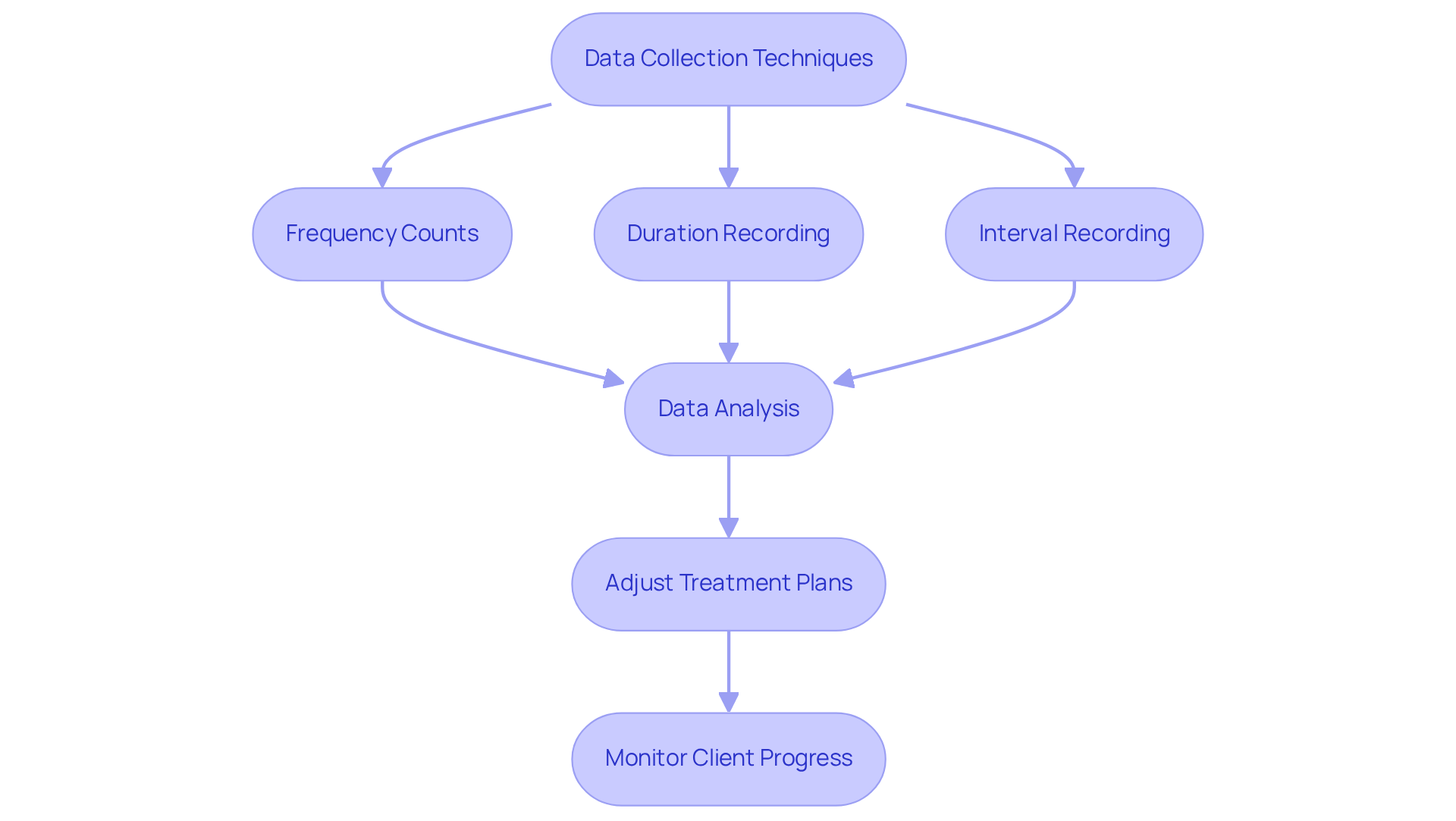
Parent training is crucial for equipping families with the knowledge and skills necessary to support their children's development beyond therapy sessions. Board Certified Behavior Analysts (BCBAs) must prioritize educating parents in applied behavior analysis techniques, reinforcement strategies, and effective communication skills. Research shows that when parents actively engage in applied behavior analysis techniques during interventions, the overall effectiveness of therapy improves, leading to enhanced outcomes for children. For instance, studies indicate that 90% of individuals exhibit progress with recommended ABA therapy, especially when parents consistently implement learned skills at home, thereby reinforcing the therapy's impact.
Successful parent training programs emphasize collaboration between BCBAs and families, using applied behavior analysis techniques to cultivate an environment where parents feel empowered and supported. Programs that integrate positive quotes, such as 'Every individual has potential. ABA helps unlock it,' can inspire caregivers and affirm their role in the therapeutic process. Additionally, quotes like 'Where others see chaos, ABA sees communication' underscore the transformative nature of ABA therapy, encouraging parents to perceive challenges as opportunities for growth.
Recent studies highlight that parental involvement in behavior management not only enhances skill development but also promotes emotional well-being within families, reducing stress and fostering resilience. For example, the case study 'The Lasting Impact of Positive Quotes on Autism Parenting' demonstrates how positive affirmations can cultivate resilience and hope among caregivers.
By emphasizing parent training, Board Certified Behavior Analysts can create a more cohesive support system that integrates applied behavior analysis techniques to bridge therapy and home life, ultimately leading to more significant and lasting improvements in children's behavior and development. To enhance parent training, BCBAs can consider the following actionable tips:
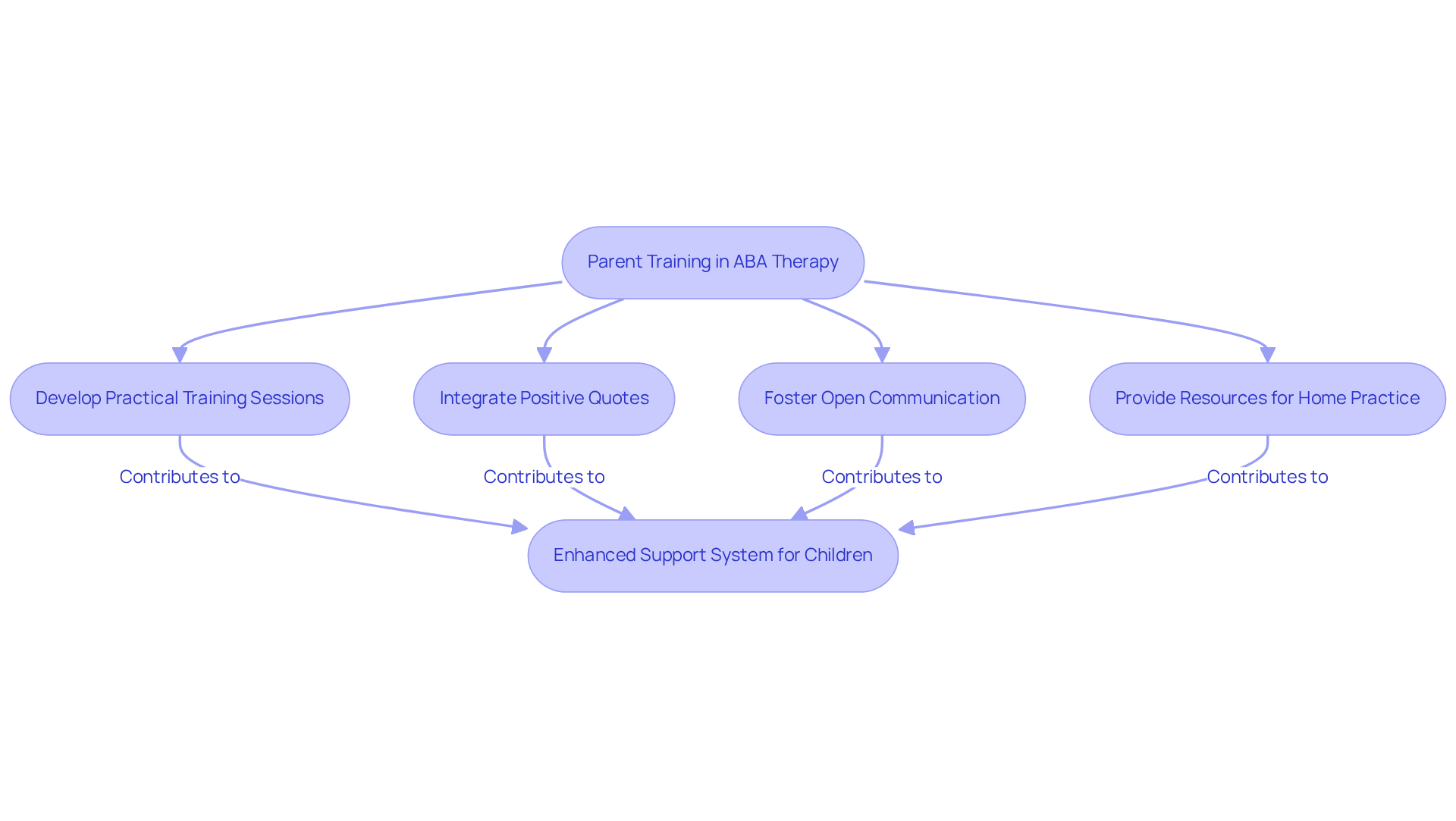
The application of essential applied behavior analysis (ABA) techniques is crucial for Board Certified Behavior Analysts (BCBAs) in enhancing therapeutic outcomes for individuals, particularly those with autism. The growing demand for BCBAs underscores the necessity of employing effective strategies that not only improve client outcomes but also elevate the overall quality of ABA therapy. By integrating these techniques into practice, BCBAs can effectively address behavioral challenges, promote skill acquisition, and empower families, ultimately fostering a supportive environment conducive to growth and development.
Throughout this article, key techniques such as:
have been explored in depth. Each technique offers unique benefits: encouraging desired behaviors through reinforcement, facilitating structured skill acquisition, and enhancing communication through visual supports. Moreover, the importance of data collection and analysis, along with parent training, has been emphasized as vital components in tracking progress and ensuring the longevity of therapeutic gains.
By embracing these essential techniques and fostering collaboration with families, behavior analysts can unlock the full potential of their clients, paving the way for meaningful and lasting change. The future of ABA is bright, and the time to act is now—implement these strategies to make a significant impact in the lives of those you serve.
What is Hire ABA and what does it offer?
Hire ABA is a specialized recruitment platform designed to enhance the job search experience for Board Certified Behavior Analysts (BCBAs) by matching qualified candidates with premier job opportunities in ABA therapy using advanced algorithms and industry connections.
How does Hire ABA improve the recruitment process for BCBAs?
Hire ABA utilizes personalized resume assessments to evaluate candidates' experience and career goals, applying advanced job fit scoring to identify opportunities that align with their skills and preferences, thereby streamlining the job search process for candidates and helping employers find the right talent efficiently.
What evidence supports the effectiveness of Hire ABA?
Successful case studies indicate that platforms like Hire ABA significantly improve job placement success rates, demonstrating the essential role of technology in recruitment processes.
What is positive reinforcement in applied behavior analysis (ABA)?
Positive reinforcement is a technique that involves providing a reward immediately after a desired behavior to increase the likelihood of its recurrence. It can take various forms, such as verbal praise, tokens, or tangible rewards, and is tailored to meet individual client needs.
How can positive reinforcement be effectively implemented?
Positive reinforcement can be combined with shaping techniques, such as establishing a token economy system, to break down complex abilities into manageable steps, teaching delayed gratification and encouraging skill development.
Why is family engagement important in positive reinforcement strategies?
Family engagement is crucial as parents can reinforce preferred actions beyond therapy sessions, creating a supportive atmosphere that enhances the structured education provided by behavior analysts.
What is Discrete Trial Training (DTT) and its purpose?
DTT is a systematic method that breaks down abilities into small parts for targeted instruction and evaluation. It is effective for teaching various skills, especially for clients on the autism spectrum, by providing clear instructions, responses, and consequences.
How is success measured in DTT programs?
Success in DTT is measured by clear mastery criteria, such as achieving a specific number of consecutive correct responses, and relies on immediate positive reinforcement to solidify learning connections.
How can DTT be integrated with other training methods?
DTT can be integrated with natural environment training (NET) to help children apply acquired abilities in real-world situations, significantly improving their communication and interaction skills.
What is necessary for effective implementation of DTT strategies in healthcare settings?
Effective implementation of DTT requires regular training sessions for staff and continuous collaboration with families to ensure that the method is tailored to each individual's unique needs.
Our expert recruitment strategies and AI-driven sourcing ensure that you receive top-notch candidates quickly, without compromising on quality. Whether you’re looking for BCBAs, Clinical Directors, or RBTs, we’ve got you covered.